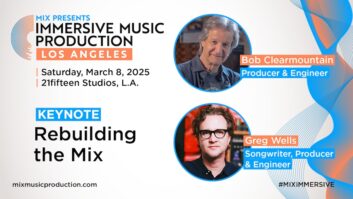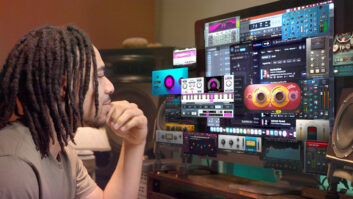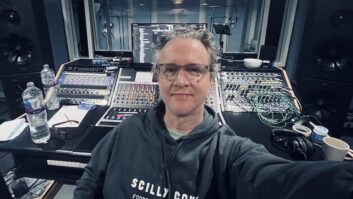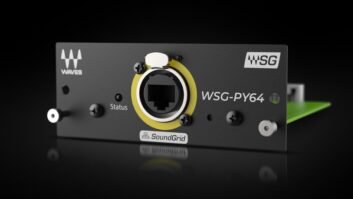
The Greg Wells Signature Series bundle comprises three plug-ins: MixCentric, VoiceCentric and PianoCentric. It’s designed to give you great-sounding mixes, and vocal and keyboard tracks, lickety-split and with minimal fuss. The bundle is the result of a collaboration between Waves and Greg Wells, the multiple Grammy Award–nominated producer, songwriter and mix engineer whose work with Adele, Katy Perry, OneRepublic and others has sold more than 85 million units.
I reviewed Version 9.6.41.1 of VoiceCentric and 9.6.9.22 of MixCentric and PianoCentric, using Digital Performer V. 9.02 with an 8-core Mac Pro running OS X 10.9.5.
Common Ground
Although the three plug-ins use different blends of processing, their simple control layouts share many similarities (see Fig. 1). For each plug-in, Waves recommends that you adjust the input gain so that a virtual sensitivity LED lights yellow. Then reduce the output gain a commensurate amount to re-establish unity gain. At the center of each GUI is a large, continuously variable rotary control—labeled Intensity (for MixCentric and VoiceCentric) or Piano (for PianoCentric)—that adjusts the amount and types of the plug-in’s primary processing applied.
It is intended that MixCentric be placed on your master bus or a subgroup. The plug-in’s I/O-gain controls adjust respective levels ±18 dB in 0.1dB increments. The Intensity control adds EQ, compression and harmonic distortion as you rotate it clockwise. The operation manual suggests you set the Intensity (threshold) control so that roughly 1.5 to 2 dB gain reduction shows on the included gain-reduction meter to start. Once you have MixCentric sounding the way you want on a full mix, add a third-party limiter of your choice after MixCentric to finalize levels.
VoiceCentric’s GUI includes a central Intensity control that adds compression, EQ, harmonic distortion and other unspecified processing. Some of the processing doesn’t kick in until the Intensity control is turned up 60 to 80 percent of the way to max. The operation manual suggests you aim for 3 to 4 dB of gain reduction to start. Three additional controls progressively add stereo delay (which automatically syncs to your DAW’s tempo), doubler and reverb, respectively; each provides their own bypass. VoiceCentric’s output gain control provides a ±24dB range.
PianoCentric’s Piano control is bi-polar, producing two different types of sounds as you rotate the control from the noon position. Rotate the control clockwise from noon for a punchy sound that will cut through your mix. For a filtered lo-fi sound, rotate the Piano control counter-clockwise from noon. Additional controls are provided to independently insert stereo delay and doubler into the signal path; each processing block has its own bypass and volume control. As in MixCentric, PianoCentric’s I/O-gain controls adjust respective levels ±18 dB in 0.1dB increments.
The bundles’ cross-platform plug-ins accommodate standard sampling rates up to 96 kHz and both mono and stereo channel configurations. With the exception of MixCentric, they also support mono-to-stereo configuration. That said, the delay, doubler and reverb provided by some of the plug-ins are all designed with stereo operation in mind. All three plug-ins provide factory presets that serve as good starting points for processing. The plug-ins’ input levels don’t change as you recall different presets, aiding your workflow.
Mixing Tracks
To test each plug-in in the bundle, I placed them on either a stereo track or a stereo aux fed by the source track; stereo instantiations ensured the best possible results when using the delay, doubler or reverb provided by some of the plug-ins.
I loved the variety of modern sounds I could get using PianoCentric on a grand piano. Setting the Piano control to the 1 o’clock position and adding a tiny bit of doubling gave an organically rich and clear sound that cut through the mix, while setting the Piano control to around 8:30 and cranking the doubler yielded a lush and heavily filtered sound that was great for a pop production. PianoCentric also sounded fantastic on a stem containing Rhodes piano and synth pad. I set the Piano control barely past the 1 o’clock position, the doubler to about 12:30 and the delay to the noon position. The result sounded wider, richer and more three-dimensional. Loved it!
Placed on a female lead vocal track, the VoiceCentric plug-in very transparently controlled level fluctuations with the Intensity control raised enough to produce 3 to 4 dB of gain reduction. The reverb sounded like a diffuse chamber with unobvious early reflections (ER) and good, middle-of-the-road tonality—not too bright or bass-y. But even with very little ‘verb dialed in, the reverb-decay time was sometimes a bit long for uptempo songs. As it doesn’t offer independent controls for adjusting decay time, ER level, pre-delay, damping and other key parameters, I regard the reverb mostly useful for rough demo productions where precise tailoring to the money track isn’t critical.
VoiceCentric’s stereo delay sounded good, but I wished I could control the number of voices, feedback level (number of repeats) and high-frequency roll-off for the effect separately from its volume. Again, I wanted much greater control when mixing the money track for a commercial release.
VoiceCentric’s doubler sounded good on lead vocals when used in moderation; it sounded too chorus-y for my tastes when cranked. This is not the type of doubling you would get by using early reflections or, say, a lightly modulated 40ms delay line. VoiceCentric’s doubling sounds tighter (and less intense) than that, and it produces watery-sounding pitch modulation at very high settings. This is inherently neither good nor bad; I describe it only to inform, as there are many ways to produce doubling, and they all sound different from one another.
While I didn’t like VoiceCentric overall for use on lead vocals, it sounded fantastic on triple-tracked background vocals. Heavy processing lent a leveled, lush, wide and dimensional sound perfect for pop productions (see the “Try This” sidebar).
I got very poor results using MixCentric on an alt-rock mix that had weak bass and a brittle top end. With 1.5 to 2 dB of gain reduction on peaks, MixCentric made the mix sound louder but also a lot thinner and edgier. High frequencies sounded like they were heavily boosted, dramatically emphasizing the sizzle of snares and hi-hat hits (which already sounded too bite-y before processing). The bottom end sounded weaker on my full-range system and on Yamaha NS-10M Studio monitors alike; bass guitar—which sounded very understated on the dry mix and needed bolstering—was further weakened after MixCentric processing.
All this led me to surmise MixCentric might help a muddy, bass-heavy mix that needs bass cut, compression and high-frequency boost. But even so, there’s absolutely no substitute for dialing in each process—EQ, compression and so on—separately to the degree each is needed (if at all) for a specific mix. A single knob controlling multiple, fixed processes (and lacking an analysis engine) can’t possibly get a mix balance sounding great more often than once in a blue moon, and then only by sheer chance.
Mixed Bag
PianoCentric is the clear standout in the Greg Wells Signature Series bundle, producing a wide variety of both organic and lo-fi sounds for keyboard tracks. While VoiceCentric sounds fantastic on BVs, it doesn’t offer enough parameter controls to mesh a typical lead vocal’s unique characteristics with a particular production. And MixCentric’s ready-made combinations and chaining of multiple processes are way too arbitrary to use on mixes for reliable results. Each of the bundle’s plug-ins is also available for individual purchase at reasonable prices. PianoCentric, in particular, is a good buy at $149.
Michael Cooper is a recording, mix, mastering and post-production engineer and a contributing editor for Mix magazine.
TRY THIS
For tight, ultra-lush BVs, place VoiceCentric on a stereo aux. Hardpan high and low BVs on the sends routed to VoiceCentric’s inputs. Crank the Intensity control to level the BVs. Set the doubler’s level to 3 o’clock position and the delay to noon.
Product Summary
COMPANY: Waves
PRODUCT: Greg Wells Signature Series
WEBSITE:waves.com
PRICE: $349
PROS: PianoCentric sounds fantastic on keyboard tracks. VoiceCentric produces transparent compression and chorus-y doubling, sounds great on BVs. Delays automatically sync to DAW’s tempo.
CONS: VoiceCentric’s delay and reverb don’t offer separate parameter controls. MixCentric’s processing sounds edgy and bass-lean, is a crapshoot for use on full mixes.






